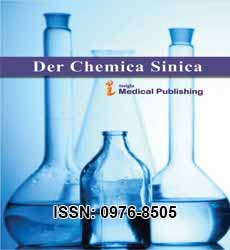ISSN : 0976-8505
Der Chemica Sinica
Catalytic Activity of Transition Metal Complexes in Organic Reactions
Smedley Glenn*
Department of Chemistry, Cairo University, El-Kasr El-Aini Street, 11562, Cairo, Egypt
*Corresponding author:
Smedley Glenn,
Department of Chemistry, Cairo University, El-Kasr El-Aini Street, 11562, Cairo, Egypt,
E-mail: smedley@glenn.eg
Received date: January 01, 2025, Manuscript No. IPDCS-25-20594; Editor assigned date: January 03, 2025, PreQC No. IPDCS-25-20594 (PQ); Reviewed date: January 15, 2025, QC No. IPDCS-25-20594; Revised date: January 22, 2025, Manuscript No. IPDCS-25-20594 (R); Published date: January 28, 2025, DOI: 10.36648/.16.1.1
Citation: Glenn S (2025) Catalytic Activity of Transition Metal Complexes in Organic Reactions. Der Chemica Sinica Vol.16 No.1:1
Introduction
Transition metal complexes have long been recognized as powerful catalysts in organic synthesis, owing to their ability to activate substrates, facilitate bond formation and cleavage, and offer remarkable selectivity under mild conditions. Their variable oxidation states, flexible coordination environments, and strong interaction with organic ligands enable them to accelerate a wide range of reactions that are otherwise slow or inefficient. The catalytic activity of these complexes not only enhances reaction efficiency but also plays a pivotal role in advancing sustainable chemistry by reducing energy consumption and minimizing by-products [1].
Description
The unique catalytic potential of transition metal complexes lies in their electronic configurations, which allow them to participate in electron transfer processes essential for many organic reactions. Metals such as palladium, nickel, ruthenium, rhodium, and copper form stable complexes with ligands that fine-tune their reactivity, enabling processes such as Câ??C bond formation, hydrogenation, oxidation, and polymerization. The success of reactions likes cross-coupling and olefin metathesis is attributed to the exceptional catalytic properties of these complexes, which have transformed synthetic organic chemistry by providing efficient routes to complex molecules [2].
A key advantage of transition metal catalysis is the control it offers over reaction selectivityâ??be it chemo-, regio-, or stereoselectivity. For instance, chiral ligands in metal complexes have enabled enantioselective transformations that are critical in pharmaceutical synthesis, where the biological activity of molecules often depends on stereochemistry. Additionally, the ability to design ligands that alter the electronic and steric environment of the metal center allows chemists to tailor catalysts for specific transformations, enhancing yield and reactions [3].
Beyond laboratory-scale applications, transition metal complexes are vital in industrial processes. Large-scale catalytic systems such as hydroformylation, Fischerâ??Tropsch synthesis, and Zieglerâ??Natta polymerization rely heavily on the activity of transition metal complexes. Their role in green chemistry is equally significant, as they enable atom-economical reactions and promote the use of renewable feedstocks. Ongoing research focuses on improving catalyst stability, recyclability, and minimizing the use of rare and expensive metals by developing earth-abundant alternatives like iron and cobalt complexes, which can sustain industrial demands while being environmentally and economically feasible [4].
Transition metal complexes are increasingly being engineered with tunable ligands that allow precise control over reactivity, selectivity, and product distribution, thereby enhancing their efficiency in complex transformations. Advances in computational chemistry and mechanistic studies provide deeper insights into catalytic pathways, enabling the rational design of next-generation catalysts tailored for specific industrial applications. In parallel, efforts in heterogeneous catalysis are bridging the gap between molecular-level understanding and large-scale deployment, allowing for more robust systems that combine high activity with ease of recovery and reuse [5].
Conclusion
The catalytic activity of transition metal complexes has revolutionized organic synthesis by providing efficient, selective, and sustainable pathways for diverse chemical transformations. Their impact spans from fine-tuned laboratory reactions to large-scale industrial processes, underscoring their indispensable role in modern chemistry. As research continues to optimize catalyst design and explore abundant metal alternatives, transition metal complexes will remain at the forefront of innovation, driving progress in both organic chemistry and sustainable industrial practices.
Acknowledgement
None.
Conflict of Interest
None.
References
- Yuan W, Munotz B, Wong CH (1993) Development of Selective Tight-Binding Inhibitors of Leukotriene A4 Hydrolase. J Med Chem 36: 211–220
Google Scholar Cross Ref Indexed at
- Robello M, Barresi E, Baglini E, Salerno S, Taliani S, et al. (2021) The Alpha Keto Amide Moiety as a Privileged Motif in Medicinal Chemistry: Current Insights and Emerging Opportunities. J Med Chem 64: 3508–3545
Google Scholar Cross Ref Indexed at
- Yao M, Dong S, Xu X (2024) Asymmetric Carbene Transformations for the Construction of All-Carbon Quaternary Centers. Chem Eur J 30: e202304299
Google Scholar Cross Ref Indexed at
- Cavé C, Desmaële D, d’Angelo J (1996) Stereochemical Aspects in the Asymmetric Michael Addition of Chiral Imines to Substituted Electrophilic Alkenes. J Org Chem 61: 4361–4368
Google Scholar Cross Ref Indexed at
- Pang SY, Wong YT, Yuan SG, Liu Y, Tsang MK, et al. (2019) Universal Strategy for HF-Free Facile and Rapid Synthesis of Two-Dimensional MXenes as Multifunctional Energy Materials. J Am Chem Soc 141: 9610–9616

Open Access Journals
- Aquaculture & Veterinary Science
- Chemistry & Chemical Sciences
- Clinical Sciences
- Engineering
- General Science
- Genetics & Molecular Biology
- Health Care & Nursing
- Immunology & Microbiology
- Materials Science
- Mathematics & Physics
- Medical Sciences
- Neurology & Psychiatry
- Oncology & Cancer Science
- Pharmaceutical Sciences
